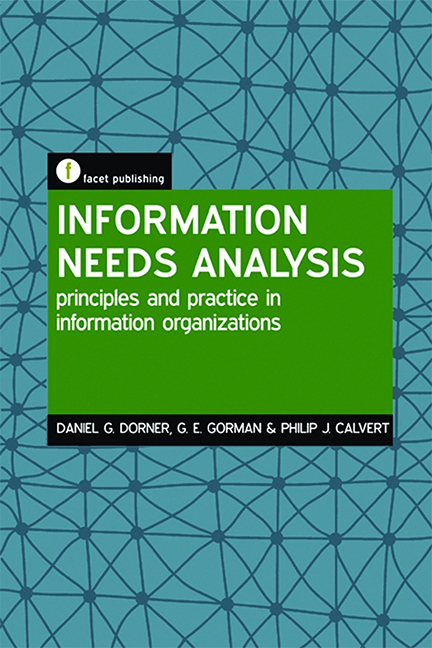Book contents
- Frontmatter
- Contents
- List of figures and tables
- List of scenarios
- About the authors
- Preface
- 1 Background to needs analysis for information managers
- 2 The importance of context in information needs analysis
- 3 Models and types of information needs analysis
- 4 The stages of information needs analysis
- 5 Gathering data for information needs analyses
- 6 Gathering data from existing sources
- 7 Gathering data through surveys
- 8 Gathering data through interviews
- 9 Analysing and integrating information needs analysis data
- 10 Reporting on an information needs analysis
- Bibliography
- Index
3 - Models and types of information needs analysis
Published online by Cambridge University Press: 10 September 2022
- Frontmatter
- Contents
- List of figures and tables
- List of scenarios
- About the authors
- Preface
- 1 Background to needs analysis for information managers
- 2 The importance of context in information needs analysis
- 3 Models and types of information needs analysis
- 4 The stages of information needs analysis
- 5 Gathering data for information needs analyses
- 6 Gathering data from existing sources
- 7 Gathering data through surveys
- 8 Gathering data through interviews
- 9 Analysing and integrating information needs analysis data
- 10 Reporting on an information needs analysis
- Bibliography
- Index
Summary
Introduction
In this chapter we identify different levels, models and types of needs analysis generally (as distinct from INA specifically) that are discussed in the literature across a variety of disciplines. The purpose of this is to distinguish key features and themes related to needs analysis models. We also examine the application of some of these models to information management (IM) contexts, and ultimately we draw upon the key elements of these models to develop our own models of INA.
When reading this chapter it is important to note the following points. Because we are often referring to the literature, we use the term ‘needs assessment’ when it has been used by the authors we are referencing, and we use the term ‘needs analysis’ when providing our own points of view and when developing our own models. And, when discussing IM contexts, we are generally talking about situations in which information services, programmes or products are being considered, planned, implemented or evaluated. However, rather than continually repeating the terms ‘services, programmes or products’ we simply use the term ‘services’ as shorthand for all three.
The purpose of this chapter, in brief, is to address three questions:
1 What are the levels of INA?
2 How do we identify different models and types of INA?
3 What contextual factors must be considered when undertaking INAs?
We begin our search for answers to these questions with a brief analysis of relevant literature.
The literature
When scanning the literature on needs analyses and assessment, we soon recognize that there are many perspectives used to group needs analyses into different categories or types. Some writers categorize needs analyses into levels based on the scope or coverage with respect to the target groups, whereas other writers identify models based on the breadth of outcomes expected or the extent or types of changes that are possible with respect to the specific contexts giving rise to and INA.
We now examine specific examples from the broader literature that illustrate various ways in which models of needs analysis have been categorized. Primary focus is on literature from international development and management, human resources development and especially education, with particular attention to the work of Kaufman and English (1979) and Witkin and Altschuld (1995).
- Type
- Chapter
- Information
- Information Needs AnalysisPrinciples and Practice in Information Organizations, pp. 45 - 66Publisher: FacetPrint publication year: 2017



